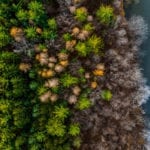It’s morning and two steadfast eyes peer above the placid waterline of the Babai River in Nepal. A pair of slender jaws abruptly whips out of the water. They belong to a gharial, a fish-eating crocodile that is critically endangered.
With fewer than 200 gharials in the wild, routine monitoring of these reptiles is necessary to ensure wildlife managers know the species’ current status to inform conservation strategies.
But how does one know how many gharials there are in the Babai River? To answer this question, Gokarna Jung Thapa of the World Wildlife Fund is flying a drone 80 metres overhead this “ecological lifeline” that supports myriad species. A GoPro camera attached to the drone captures images of the river and its shores every second. Gharials basking on the shores of the river or swimming near the river’s surface are then counted from the high-resolution images.
In their new study published in the Journal of Unmanned Vehicle Systems, Gokarna Jung Thapa and colleagues found the use of a drone to count gharials is as effective as surveys that happen by foot, but costs less and is logistically less complex.
Typically, ground-based surveys are carried out by a team of trained technicians that walk along the meandering shores of the Babai River and take photographs with a hand held camera. Technicians will survey the same 46 km segment of the river three times; it takes five days to complete one survey. In contrast, a drone can cover ~100 km of shoreline in less than three hours without disturbing basking gharials, which can occur during foot surveys.
There are several factors vexing gharial populations, including poaching and aquatic pollution. Changes in water flow are particularly problematic. The fragile geology of the Babai River means that flash floods, agricultural irrigation, and construction of dams can significantly alter water flow and reduce areas for gharials to bask and lay eggs.
While gharial populations remain threatened, drones provide a cost-effective and reliable method to count these crocodilians and identify the habitats they need to survive.
Read the full study: Counting crocodiles from the sky: monitoring the critically endangered gharial (Gavialis gangeticus) population with an unmanned aerial vehicle (UAV) in the Journal of Unmanned Vehicle Systems.




